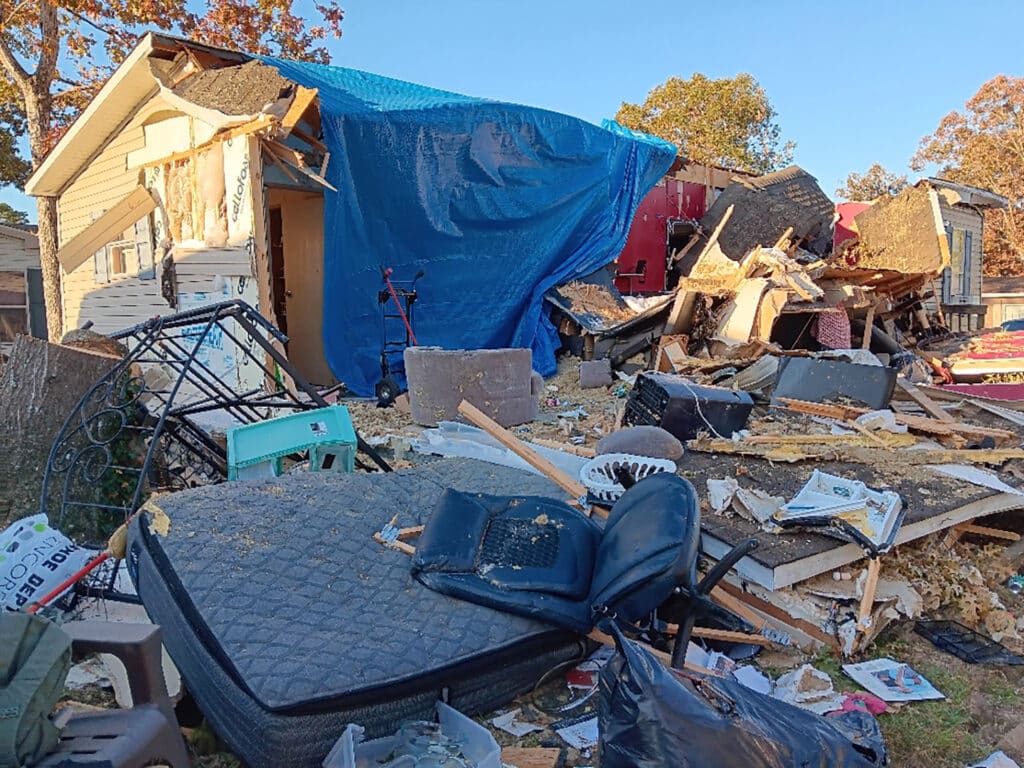TARPLEY—Tarpley is one of those towns you’ll miss if you blink while driving. Tucked away in the Texas Hill Country northwest of San Antonio, Tarpley Baptist Church had suffered similar insignificance when Elmer Franks arrived there as pastor in 2003. Years earlier, the roof had fallen in on the building, and the property was deeded to another church. The dilapidated facility built in 1940 was closed.
Franks, who was on staff down the road at First Baptist Church of Bandera, took the Tarpley church’s plight to heart. After praying about it, and after meeting with some people from the Tarpley church, he became pastor.
“The church had dwindled to nothing. On my second Sunday in the pulpit, there were four people in the service, and my wife and I were two of them,” said Franks, 83. “But there was no doubt that God wanted us there. We saw the potential because we knew there were plenty of folks living out in the boondocks.”
Franks got busy traveling the “boondocks,” meeting people, sharing the gospel, winning numerous people to the Lord and then baptizing them in the creek behind the church. Soon, the property was deeded back to Tarpley.
In 2008, however, Franks resigned. “I felt it was an injustice to stay considering my health problems and the growing needs of the church,” he said.
Emphasis on giving
During his pastoral tenure at Tarpley, Franks followed the example of his father, who “was strongly focused on giving to missions” during pastorates spanning the Great Depression. Depression aside, his father would always take an offering for the Cooperative Program upon arriving at a new pastorate, he said.
“The Cooperative Program was three years old when I was born, and I’ve grown up with it,” Franks said. “I grew up seeing what it did not only for foreign missions but for the associations and state convention too. I saw what giving to the Cooperative Program did for the churches my father pastored because every one of them grew financially and numerically because of missions giving.”
“I adopted that practice too,” Franks said. “I always led the churches I’ve pastored to give a minimum of 10 percent to the Cooperative Program. Those churches were also blessed by God. In my experience, I’ve never seen any church which gave to missions from the heart that did not grow in size and budget. But I have seen some churches quit giving to missions or cut back on their CP to support some other church program, and those churches have fallen by the wayside. They were really hurt, both in finances and in church growth and health.”
Franks eventually led the rural but growing Tarpley to give 20 percent of its undesignated receipts to missions—an amount evenly split between the Cooperative Program and the Hill Country Baptist Association.
“I’m satisfied that missions giving is the key to do what the Lord wants us to do,” Franks said. “I mean, is there any other way? As far as I’m concerned, giving to the Cooperative Program is the application of the Great Commission. We couldn’t go into all the world, but our church made it possible for others to do that.”
“I wish we had more pastors like Elmer,” said Jim Leak, Hill Country’s director of missions. “That kind of support is a great encouragement when everyone is talking about how the economy is affecting their budgets. A church that gives 20 percent—that’s a real heavy-hitter.”
“Elmer isn’t one to make a big deal of this,” Leak added. “But when he mentions supporting the Cooperative Program, he does it only to encourage other pastors regarding what their churches give to CP.”
Franks said God blessed the church’s generous commitment to missions so much that, upon his retirement the church had about $400,000 in its budget. Three-fourths of that came from a local citizen, not a member of the church, who was impressed with Franks’ efforts and the church’s growth and ministry.
Rebuilding a church
Succeeding Frank’s pastorate in May 2008 was Dick Sisk, a Criswell College and Southwestern Seminary graduate, who once pastored East Grand Baptist Church in Dallas.
“Brother Elmer did a phenomenal job bringing this church back,” said Sisk, adding that about 70 people attended a recent worship service at Tarpley. That’s up from an average of about 30 when Sisk arrived.
When Sisk saw the $400,000 in the budget and need for expansion, he led the church to put $300,000 into a building fund. That led to a building program of $800,000. Noting the outdated, 60-seat auditorium, Sisk said, “I knew we wouldn’t grow to stay beyond 80 percent of our capacity.”
“How did we raise the money?” Sisk said. “Well, we didn’t do a fund-raiser, no ‘Together We Build’ program, no pledge cards, no faith promise commitments, and no consultant.”
“In January of 2010, I challenged the people to take 40 days to pray about the program, and for each one to ask God what they should give,” said Sisk, who shared his commitment to build a new auditorium debt-free.
After the 40 days, Sisk distributed index cards to the congregation and asked the people to write on the card the amount God impressed them to give, but not to write their names.
“One of the cards read, ‘Whatever it takes,’” Sisk recalled. “That one card summed up the heart of the people. And as our building committee did the design, concept and architectural work, the people just started giving.”
Money even came in from numerous locals outside the church. And when a nearby bank loan officer called offering a “favorable low-interest rate on a loan,” Sisk said he thanked the banker and jokingly replied, “The church may have money we can loan to you.”
“When the dust settled, we had $806,000,” Sisk said. The church broke ground in May of 2010, and on March 27 it dedicated the added 7,000 square feet that entails a 120-seat auditorium, a fellowship hall and education space.
Sisk noted the church continued to give 20 percent through CP during the building project while also giving $100,000 for direct missions support, which includes the support of a missionary couple from the church who were called to international missions.
“We’re in this little ol’ valley out here and have seen God do a significant work,” Sisk said. “Our story can be an encouragement because there are thousands of churches out there like Tarpley. We’re 50 miles from nowhere, but the Lord is still using us.”














